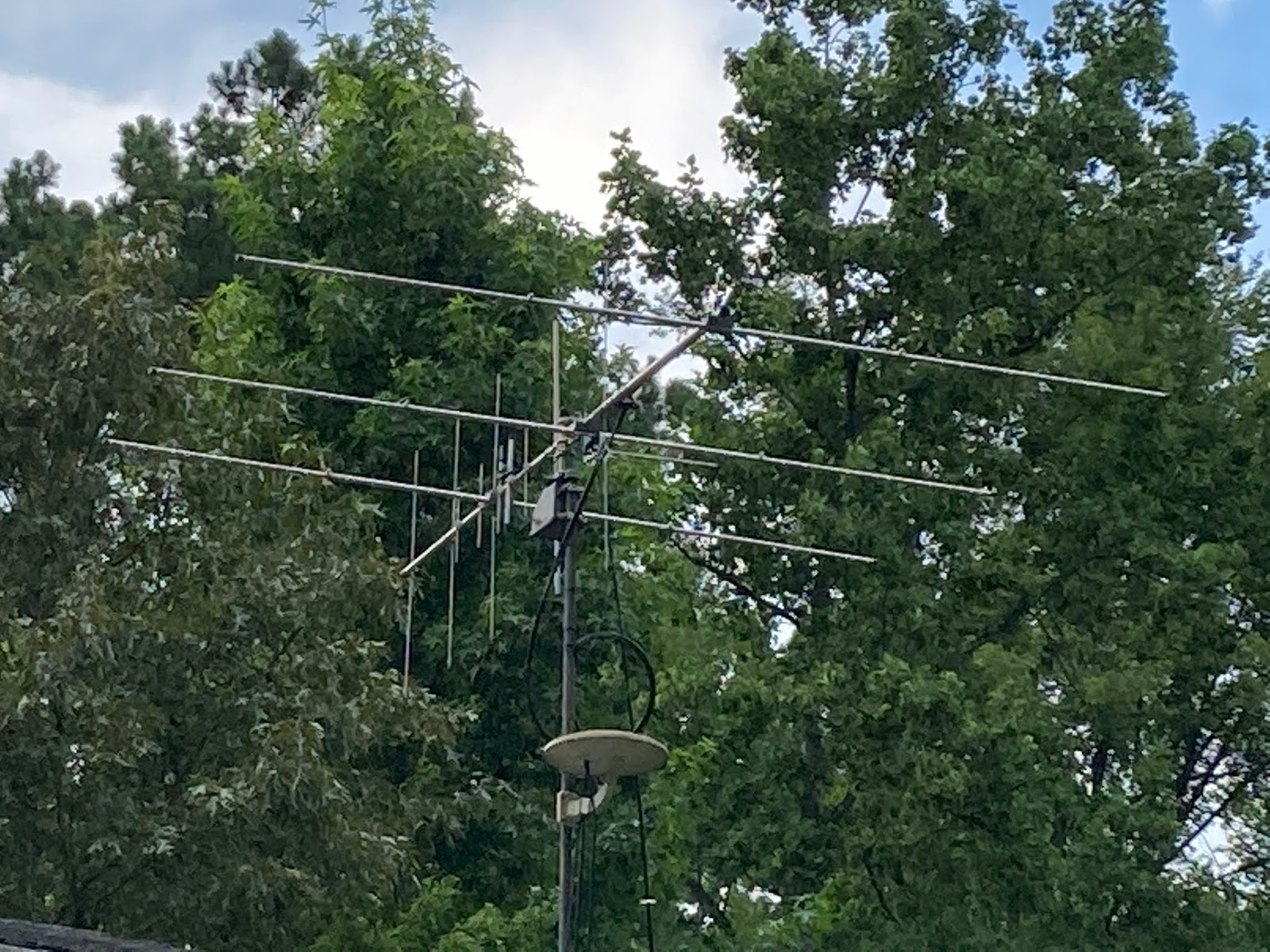 |
| Cushcraft A6270-13S. The little round white guy is a broadcast TV antenna. |
It’s a bit embarrassing that my last post was on this subject was October, 2017. However, I’m currently trying to tie up a lot of loose ends in my life, and this is one of them. I seem to have an issue completing projects with no due date, and this one is a poster child for that.
The silly thing is that I assembled it, got it up on its mast and ran the cables that same month. It’s around 25′ up and has tremendous range on 2M when used with my Kenwood TS-790A, hitting repeaters 90 miles away with good signal. 70 cm range isn’t as good, but that’s to be expected with a higher frequency and less power.
Antenna assembly was the typical MFJ nightmare. Thank God I bought the thing from DX Engineering. The original antenna had elements in the wrong places or missing along with the standard wrong, missing and damaged parts. DX Engineering wound up sending me an entire extra antenna, with instructions to try and build a good antenna and send the excess parts back on their dime. How’s that for service?
Once assembled, tuning was fairly straightforward using the gamma matches for each frequency. I was able to tune it to 1.2-1.4 SWR on all bands. Some might complain about that figure, but I find it perfectly acceptable.
You’ll note that the rotor appears to be on the small side. Cushcraft states in the manual that any mast and rotor suitable for a TV antenna will be sufficient for this antenna. Yeah, let’s talk about that.
During the IARU DX Worldwide Championship, I tried for some stations on 6M. It’s a habit of mine to punch the auto-tune button on the Kenwood TS-590S when I change bands, and I’ve made it a habit just in case something happens to be wrong with the antenna. Good thing, because the built-in tuner would not tune my antenna. I pulled the antenna cable, put my analyzer on it and found out that the best SWR I could get was around 2.5 at 51 mHz. OK…
The Monday after the contest was going to be cloudy and “cool” for most of the day, with highs and humidity only in the mid-80s. Perfect time to climb up on the roof and check out the antenna. Mrs. Freeholder graciously agreed to stay in the shack, watching the analyzer and changing bands as needed. We stayed in communication via cell phone.
When I got on the roof, I needed the antenna rotated so that the 6M match was over the roof, rather than over empty space. Hey, I watched my Roadrunner cartoons and I learned stuff. That standing in space thing never worked for Wile E. Coyote, either.
A problem immediately reared its head-the rotor wasn’t turning as it should, even though the control box indicated it was. Sparing you the gory details, troubleshooting showed that the fault was in the motor for the rotor. Before blindly springing for another motor, I wanted to do some research on the whole subject. I was betting that something I didn’t know had bitten me.
After going down that rabbit hole, I found out that my Cushcraft, with a wind loading of 2.52 sq ft, a weight of 10 pounds and a boom length of 8.54 feet, is too big for the Channelmaster 9521A rotor I had purchased. While they hide the hell out of it on their web site, using Google I finally found this document which states the rotor is designed to handle an antenna up to 15 pounds with a maximum 3′ boom. This means that it won’t handle most of Channelmaster’s own antennas. I’m less than impressed.
Diving further into the subject of masts, rotors and antennas as a system, I found out that the larger, more capable rotors from Yaesu and Hy-gain all want masts larger than mine, which is made of 1″ galvanized pipe, plus they are 4-6 times more expensive that what I paid for the admittedly insufficient Channelmaster. MThis means I would need to take down the existing antenna, dig up the mast, find the pipe to put up a larger one, buy a new rotor setup and reassemble it all.
No. My Dad had a log periodic TV antenna when I was a kid, and the thing was at least 10′ long and weighed in at a lot more than 10 pounds. An Alliance U-100 Tenna Rotor turned it from the time it went up in the 60s until we had cable TV installed in the early 80s. They’re rated for 5 sq ft of wind load with an unknown boom length and weight capacity. I feel this should work, configured properly. Before I go to all the effort and expense of new mast and rotor, I’ll get a tri-band vertical and call it good. (The two options are about the same cost, and budget is a thing.)
Right now, the plan is to find the appropriate thrust bearing (an Alliance TBB-1, made of unobtainable) or build a substitute. The thrust bearing takes the weight of the antenna, taking strain off the rotor and using the rotor for only for turning the antenna, rather than supporting and turning it. Reconditioned U-100s can be obtained from various vendors on the Intertubz. I’ve found some pages that indicate my Channelmaster controller, which is set up in degrees, can be made to work with the U-100 motor. If not, the original controller works in 10 degree increments, and that will probably be good enough. I’m not in a big hurry, although I have set a due date of “cold weather”, to help me keep the project moving. Stay tuned because Part 7 will be the final part of this saga, one way or the other.


